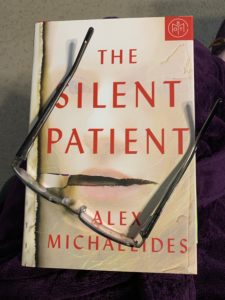
When I posted about The Silent Patient by Alex Michaelides, I wondered how many people actually engage with the text of mysteries or thrillers instead of just skimming to find out how the story ends. Michaelides leads the reader along so scintillatingly that a large part of the pleasure of reading this novel lies in recognizing the significance of its stylistic details.
A good example of how this process works occurs early in the novel, when first-person narrator Theo Faber joins his wife, Kathy, an actress, at a bar: “I went to meet Kathy at the National Theatre café on the South Bank, where the performers would often congregate after rehearsal” (p. 45). Kathy is telling “a couple of fellow actresses” the story of how she and Theo met. “It was a story she enjoyed telling,” says Theo.
Kathy begins her story of the night she was at a bar with a guy she wasn’t really interested in “‘when suddenly it happened—Mr. Right walked in.’ Kathy looked at me and smiled and rolled her eyes. ‘With his girlfriend’” (p. 46).
“This part of the story needed careful handling to retain her audience’s sympathy,” Theo tells us.
Notice what is actually going on here. Kathy, an actress, is performing for her acting friends. This is a well rehearsed story that she enjoys telling with melodramatic effect.
Theo’s narrative of Kathy’s performance continues: “No, but . . . darling . . . seriously, it was love at first sight. Wasn’t it?” Kathy asks, turning to Theo.
“This was my cue,” Theo says. “I nodded and kissed her cheek. ‘Of course it was. True love.’”
Once again, notice what is actually going on here. Kathy is performing, but so is Theo. They have obviously told this story together several times. The statement “This was my cue” lets us know that he is in on the performance.
So Theo, like Kathy, is a performer. Maybe the entire narrative he’s telling in this book is a performance, too.
Theo’s story of coming upon Kathy telling her friends how they met ends, but he continues with his own memory of what happened later that night. Theo tells us that he and Kathy went back to his apartment and made love all night:
I remember so much white everywhere: white sunlight creeping around the edges of the curtains, white walls, white bedsheets; the whites of her eyes, her teeth, her skin I’d never known that skin could be so luminous, so translucent: ivory white with occasional blue veins visible just beneath the surface, like threads of color in white marble. She was a statue; a Geek goddess come to life in my hands. (p. 48)
It’s a dreamily descriptive passage. And it echoes something Theo has earlier described for us, the self-portrait she labeled Alcestis that Alicia painted in her studio while at home, under house arrest, awaiting trial. Here’s Theo’s description of the painting:
The painting is a self-portrait, depicting Alicia in her studio at home in the days after the murder, standing before an easel and a canvas, holding a paintbrush. She is naked. Her body is rendered in unsparing detail: strands of long red hair falling across bony shoulders, blue veins visible beneath translucent skin. . . . She is captured in the act of painting—yet the canvas is blank, as is her expression. (p. 9)
The whiteness of this mostly blank canvas mirrors the “so much white everywhere” of his description of making love with Kathy. Kathy’s skin is luminous, while the skin of Alicia’s self-portrain is translucent. Kathy’s skin reveals “occasional blue veins visible just beneath the surface,” while the painting portrays “blue veins visible beneath translucent skin.”
By means of these descriptive echoes, Michaelides demonstrates that, from very early on in the narrative, Kathy and Alicia are associated in Theo’s mind. The two women are similar in another way as well: Kathy is an actress, and Alicia gives herself the name of a character in an ancient Greek play.
The metaphors of drama and acting run throughout the novel. Such thematic and verbal repetitions reinforce and drive the meaning of Theo’s narrative.
As the tension builds and the novel nears its end, Theo’s narrative becomes surrealistically chaotic, with no clear timeline and no smooth transitions from one place to another or from one grouping of characters to another. Chapters tumble one after the other toward the inevitable ending. But like the earlier examples, such stylistic significance is easy to miss if one is skimming rather than reading closely.
For Further Reading
For another example of close textual reading see A CLOSE READING OF THE BEST OPENING PARAGRAPH OF ALL TIME.
© 2019 by Mary Daniels Brown

